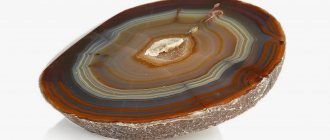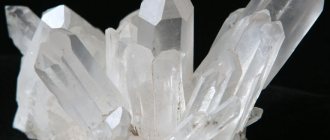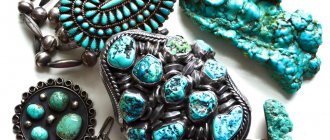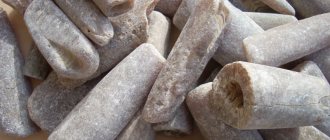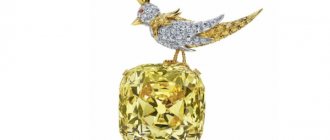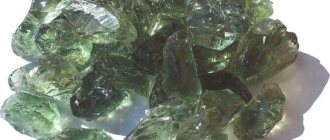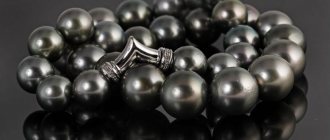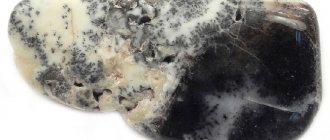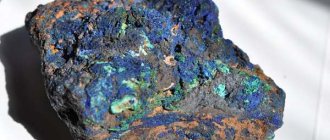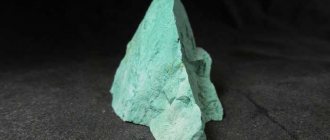Diopside is a stone that belongs to the silicates from the pyroxene group. The compound name from Greek can be translated as “two-faced”; the stone owes its name to the birefringence of the crystals. The mineral is also called malacolite and alalite. In nature, it is often found in the form of prismatic crystals.
- Color: colorless, white, gray, green, brown-yellow, blue, purple, black.
- Hardness on the Mohs scale: 5.5–6 points.
- Density: 3.25–3.55 g/cm3.
Discovery History
According to some reports, diopside was first discovered in the Ala River valley, which is located in the Italian city of the same name.
Gem-quality chrome diopside was discovered relatively recently - in 1968. But it was officially allowed to put it up for sale only in 1988, although the Siberian treasure came onto the market earlier, illegally. Geologist Anatoly Mikhailovich Korchagin described the stone in detail. Since the isolation of chrome diopside as an independent variety, it has been mined mainly in Eastern Siberia, in the Republic of Sakha (Yakutia). The buyer of large quantities of chrome diopside is China. The green stone attracted interest from the very beginning as an affordable alternative to emerald and was even advertised as the Yakut emerald in the 1990s.
In 2013, the largest diopside deposit was discovered in Tanzania. Some well-known jewelry brands in the domestic market such as Sino Jewel and Enzo have been promoting diopside jewelry since 2013.
Crystallographic characteristics
Monoclinic system; prismatic c. With. L2PC. Etc. gr. C2/c (C 62h).
a0 = 9.73; b0 = 8.89; c0 = 5.24; β = 105°51′. Z = 4.
Crystal structure of diopside
Structure Atypical for clinopyroxenes. Simple chains of silicon-oxygen tetrahedra are extended parallel to the c axis and are connected to each other by magnesium and calcium atoms, which are in octahedral coordination with respect to the oxygen atoms. The two additional oxygens attached to each calcium atom are located at a slightly greater distance. The chain structure determines the prismatic habit of the crystals.
Main forms: a {100}, b {010}, m {110}, s {111}, c {001}, p {101}, u {111}, o {221} and f {310}; (110)
< (110) = 92°50′, (001) <(100) = 74°10\ (001) < (010) = 31°19′, (001) < (111) = 33°49′, (111) <� (100) = 53°58′, (111) < (010) = 60°24′.
Production
Diopside is quite common in igneous and metamorphic rocks, found in pebbles in Sri Lanka. Large, gem-quality samples typically weigh no more than 15–20 carats.
Deposits of diopside and its varieties are being developed in Burma, the Canadian city of Ontario, the USA (states of California and Illinois), Finland, Italy, Australia, India, and the Republic of South Africa (Kimberley).
In Russia, the mineral is mined in the Murmansk and Sverdlovsk regions, in the Baikal region, and in the Inaglinskoye deposit (Yakutia).
Products with diopside
Diopside is used to make:
- rings;
- brooches;
- bracelets;
- pendants;
- souvenirs;
- cufflinks
The cut can be stepped, brilliant, or in the form of a cabochon or baguette.
Icons are decorated with beads made from diopsides.
Large diopsides are used to make small dishes and household items.
Varieties
Diopside contains impurities in large quantities; depending on this, the following varieties are distinguished:
- chrome diopside - emerald-colored diopside;
- star diopside, or black star, is a black stone with an asterism effect;
- laurelite - apple green variety;
- violan - a stone of purple, lilac or blue color;
- shefferite is a red-brown mineral;
- zinc shefferite - contains significant quantities of zinc;
- jeffersonite - there are samples of shades from apple green to brown and almost black;
- baicalite is a blue variety, mined on Lake Baikal.
There are also black diopsides with the optical effect of asterism and stones with a cat's eye effect.
Interesting facts about the stone
Certain facts are known about each mineral of natural origin. It is useful for all people to know about such things, and not just those who are interested in studying stones:
- Diopside exhibits the effect of asterism. This property is manifested due to the presence of crystalline inclusions in natural samples.
- The American Museum of Natural History is the proud owner of a transparent natural specimen. This green mineral weighs 38 carats.
- Not only jewelry with this gem, but also decorative items made from it serve as a good talisman.
- The mineral is of particular importance for people named Anastasia, Julia, Nikolai or Arthur.
Diopside is valued not only for its external beauty, but also for its magical and healing powers. The stone suits almost everyone. However, when choosing a talisman, you still need to take into account your zodiac sign. Then the mineral will definitely not cause harm, and its impact on the life and destiny of the owner will be truly positive.
Physicochemical characteristics
Diopside is not the hardest stone, and it is characterized by cleavage. The stone is soft and fragile. Density increases as the proportion of iron or chromium increases. Almost does not decompose in acids. The mineral is quite rarely free of impurities; usually its composition contains manganese, iron, aluminum, chromium, titanium, vanadium and other elements in varying proportions.
The phenomenon of pleochroism is absent in pure diopside, and its varieties show color variability from yellow-green to emerald green and from pale green to brown-green depending on the viewing angle. Diopside is characterized by a slight glassy luster.
Diagnostic signs
Like hypersthene, from which diopside differs in color. Well-formed diopside crystals differ from augite crystals in their appearance (predominant development of vertical pinacoids) and gray or light greenish shades of color. But, since diopside is capable of forming isomorphic mixtures with various other pyroxenes, its accurate diagnosis can only be made by determining optical constants, and in some cases, using chemical analysis.
Mineral satellites Garnet, magnetite, calcite, quartz, epidote.
Astromineralogy and magical properties
It is believed that diopside helps to achieve the sympathy of others and location. To do this, wear a ring with this stone on the left hand. Talismans with diopside are recommended for doctors, teachers, and representatives of the law. The properties of the mineral have been noted, such as the ability to improve intelligence and increase the desire to learn. Representatives of astromineralogy are confident that diopside helps reduce aggression and stubbornness. The mineral is believed to stimulate creativity.
Representatives of all zodiac signs can wear jewelry with this stone. Only Aries and Capricorns are recommended to wear it with caution. Diopside especially favors Gemini, Virgo and Pisces.
Medicinal properties of diopside
In lithotherapy, diopside is known as an effective stimulator of the cardiovascular system.
It prevents the development of angina pectoris, myocardial infarction, thrombophlebitis and atherosclerosis. The healing properties of the stone directly depend on its setting. For example, when diopside and silver are combined, it becomes a prophylactic against viral diseases and respiratory diseases (ARVI, influenza, bronchitis, tuberculosis, lung cancer). In this case, the stone is worn in the form of a ring or bracelet on the left hand. Diopside in a gold frame and on the right hand has a positive effect on the functioning of the digestive system.
In addition, diopside is considered a good helper in cases of nervous diseases, depression, fears and excessive aggressiveness. In such conditions, after contact with the mineral, a person becomes calm, confident, and his mood and morale improve significantly.
How to spot a fake
Synthetic analogues are not produced for the jewelry industry. Diopsides are rarely counterfeited, as this is not economically feasible. In the 90s, chrome diopsides themselves were used as imitation emeralds; today this practice is not common. But still, the following can be found as imitations of diopside:
- colored glass;
- cubic zirconia, spinel, corundum of a similar color;
- doublets and triplets: glass + natural diopside.
Natural stone can be distinguished from glass by how quickly the sample heats up in your hands: glass will heat up immediately, while stone will remain cold longer. In addition, inclusions can be discerned in the structure of natural diopside with the naked eye; it will not be perfectly homogeneous.
The most reliable way to check is to contact a gemological laboratory.
Jewelry and other products
Not all jewelers undertake to work with this problematic stone. The combination of fragility and softness is not the best for jewelry processing. But once having revealed the beauty hidden in uncut crystals, the jeweler will no longer be able to refuse to work with diopside.
The soft stone is hidden in a frame and made into earrings, bracelets, rings, and beads. Most often, completely transparent varieties of beautiful shades are chosen for this. Amazing jewelry is made from Jeffersonite. The stars that sparkle in the stones under directional lighting make them real works of art.
Caring for diopside jewelry
Diopside is quite fragile, so the main rule for caring for jewelry with this stone is careful handling. Jewelry with it should be stored separately from other jewelry. Clean rings, earrings and bracelets with diopside and its varieties as they become dirty, using running water and a mild soap solution. Cleaning agents and brushes must not be used. Dry the decoration with a soft cloth. Diopside is a stone that belongs to the silicates from the pyroxene group. The compound name from Greek can be translated as “two-faced”; the stone owes its name to the birefringence of the crystals. The mineral is also called malacolite and alalite. In nature, it is often found in the form of prismatic crystals.
- Color: colorless, white, gray, green, brown-yellow, blue, purple, black.
- Hardness on the Mohs scale: 5.5–6 points.
- Density: 3.25–3.55 g/cm3.
How to care for stone
Diopside 33x35x20 mm
It has already been mentioned that the stone is fragile. When it comes to caring, you need to follow simple rules so that you can enjoy your jewelry for as long as possible. Store in a separate box wrapped in soft cloth.
Care without using abrasives or chemicals, using only warm water and a soft brush. Sometimes you can make a soap solution. Wipe carefully with a soft cloth. Protect from mechanical damage.
In pendants, pendants, and earrings, the stone is preserved better than in a ring, ring, or bracelet.
Discovery History
According to some reports, diopside was first discovered in the Ala River valley, which is located in the Italian city of the same name.
Gem-quality chrome diopside was discovered relatively recently - in 1968. But it was officially allowed to put it up for sale only in 1988, although the Siberian treasure came onto the market earlier, illegally. Geologist Anatoly Mikhailovich Korchagin described the stone in detail. Since the isolation of chrome diopside as an independent variety, it has been mined mainly in Eastern Siberia, in the Republic of Sakha (Yakutia). The buyer of large quantities of chrome diopside is China. The green stone attracted interest from the very beginning as an affordable alternative to emerald and was even advertised as the Yakut emerald in the 1990s.
In 2013, the largest diopside deposit was discovered in Tanzania. Some well-known jewelry brands in the domestic market such as Sino Jewel and Enzo have been promoting diopside jewelry since 2013.
Areas of use
Diopside is considered a semi-precious and ornamental stone. It is often used among:
- Collectors. Unusual untreated specimens are often used to add to private collections. Options in which one color smoothly flows into another are especially appreciated. Also, collections often contain specimens of interesting shapes or crystals fused with other rocks.
- Designers. Souvenirs, memorable items or small details to complement the interior are made from processed crystals. Due to their softness, stones are easy to process, so among crafts made from natural crystals you can often see products made from malacolith.
- Jewelers The variety of colors, prevalence, softness and strength of the rock - all this makes diopside popular among creators of jewelry made from natural minerals. Jewelry turns out to be elegant and inexpensive, and thanks to its combination with other gems, it will be possible to create unique overflows and combinations.
Production
Diopside is quite common in igneous and metamorphic rocks, found in pebbles in Sri Lanka. Large, gem-quality samples typically weigh no more than 15–20 carats.
Deposits of diopside and its varieties are being developed in Burma, the Canadian city of Ontario, the USA (states of California and Illinois), Finland, Italy, Australia, India, and the Republic of South Africa (Kimberley).
In Russia, the mineral is mined in the Murmansk and Sverdlovsk regions, in the Baikal region, and in the Inaglinskoye deposit (Yakutia).
origin of name
The name of the mineral comes from the Greek words: “di” - twice, “opsis” - appearance, appearance.
Diopside is a typical binary compound and is an extreme member of the important isomorphic series CaMg[Si2O6]—CaFe··[Si2O6] (diopside—hedenbergite); varieties that are intermediate in composition are called salita (from the Sala deposit in Sweden). The additional manganese end member is iohansenite CaMnSi2O6.
Widely distributed as a rock-forming mineral in many igneous rocks, as well as in contact-metasomatic formations.
Varieties
Diopside contains impurities in large quantities; depending on this, the following varieties are distinguished:
- chrome diopside - emerald-colored diopside;
- star diopside, or black star, is a black stone with an asterism effect;
- laurelite - apple green variety;
- violan - a stone of purple, lilac or blue color;
- shefferite is a red-brown mineral;
- zinc shefferite - contains significant quantities of zinc;
- jeffersonite - there are samples of shades from apple green to brown and almost black;
- baicalite is a blue variety, mined on Lake Baikal.
There are also black diopsides with the optical effect of asterism and stones with a cat's eye effect.
Types of stone and their characteristics
Due to the mixture with various chemical elements, there are several types of diopside:
- Shefferite is a manganese-containing salite. It has a brownish color, greater fragility, and consists of many uneven crystals with a smooth surface.
- Jeffersonite is a zinc-containing salite. It looks more like a regular stone interspersed with crystals. Sometimes the appearance of green minerals resembles overgrown moss. The surface is rough, matte.
- Omphacite is a diopside containing sodium oxide. It has a brighter green color and a clear crystalline structure.
- Fassaite is an omphacite containing aluminum oxide. This crystal has a marsh or brownish tint and a matte surface.
- Chrome diopside, due to chlorine, has a bright green saturated color. It has a crystalline luster. More often than other types it is used in the jewelry industry.
Physicochemical characteristics
Diopside is not the hardest stone, and it is characterized by cleavage. The stone is soft and fragile. Density increases as the proportion of iron or chromium increases. Almost does not decompose in acids. The mineral is quite rarely free of impurities; usually its composition contains manganese, iron, aluminum, chromium, titanium, vanadium and other elements in varying proportions.
The phenomenon of pleochroism is absent in pure diopside, and its varieties show color variability from yellow-green to emerald green and from pale green to brown-green depending on the viewing angle. Diopside is characterized by a slight glassy luster.
Description and external signs
Diopside is a transparent stone with a soft structure and glassy luster . Opaque varieties are also rare. By itself, it is colorless, but the content of different elements in it colors the mineral in almost the entire palette of natural shades.
The first diopsides were found near the Ala River in Italy, so you can often find their second name: alalites. In Russia, deposits of the precious mineral were found in Yakutia at the end of the twentieth century.
Astromineralogy and magical properties
It is believed that diopside helps to achieve the sympathy of others and location. To do this, wear a ring with this stone on the left hand. Talismans with diopside are recommended for doctors, teachers, and representatives of the law. The properties of the mineral have been noted, such as the ability to improve intelligence and increase the desire to learn. Representatives of astromineralogy are confident that diopside helps reduce aggression and stubbornness. The mineral is believed to stimulate creativity.
Representatives of all zodiac signs can wear jewelry with this stone. Only Aries and Capricorns are recommended to wear it with caution. Diopside especially favors Gemini, Virgo and Pisces.
Diopside and the zodiac sign
Astrologers do not single out favorites among the zodiac signs for Diopside. Amulets with it are suitable for everyone, only Capricorns and Aries should use this stone carefully. Representatives of these zodiac signs may be prone to scams, and diopsides absolutely cannot tolerate fraud and exchange. In such cases, they can even punish their owner, so diopside can only be used with pure intentions.
How to spot a fake
Synthetic analogues are not produced for the jewelry industry. Diopsides are rarely counterfeited, as this is not economically feasible. In the 90s, chrome diopsides themselves were used as imitation emeralds; today this practice is not common. But still, the following can be found as imitations of diopside:
- colored glass;
- cubic zirconia, spinel, corundum of a similar color;
- doublets and triplets: glass + natural diopside.
Natural stone can be distinguished from glass by how quickly the sample heats up in your hands: glass will heat up immediately, while stone will remain cold longer. In addition, inclusions can be discerned in the structure of natural diopside with the naked eye; it will not be perfectly homogeneous.
The most reliable way to check is to contact a gemological laboratory.
